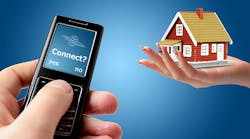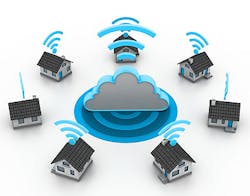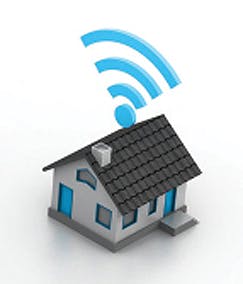Connected home is the new buzzword. Some people know them as “smart homes,” that include automation and management, wireless systems, and such. If you are a stickler for the details, and I have been known to dabble in sticklerishness, there’s a subtle difference: A connected home is one connected to the Internet, period. Some claim that a home can only be called connected if all the devices in the home are actually connected (via a gateway or set-top box) to the Internet.
Ladies and gents, I’m here to tell you that all of these things aren’t about hardware — it’s all about clouds. In the United States today, cloud-based technology is changing the way we communicate, manage our homes, and channel energy use.
For the HVAC industry, which experienced a growth year in 2013 that seems to be continuing through the end of 2014, experts say the ever-present cloud-based infrastructure is key to the growth of further development of smart HVAC system technology.
The Manufacturer Perspective
Geoff Godwin, vice president of marketing for White Rodgers, an Emerson Climate Technologies company based in St. Louis, MO, agrees. Godwin penned a story for our sister publication, HVACR & Hydronics Distribution Business magazine in January 2014 (bit.ly/SmartSys), where he examined several keys to smart home growth in the U.S. Among them:
• Smart Market
• Smart Infrastructure
• Smart Controls (costs are dropping while the number of companies offering them are on the rise).
In this forecasting article, Godwin says that 2014, from a market perspective, will be a strong year for the HVAC industry, which is the basis for his belief that 2014 will be a strong year for smart systems. From an infrastructure standpoint, he says the current state of Wi-Fi technology and reliability, combined with the soundness of Internet cloud technologies provide a more enabling means for distributed controls, wireless thermostats, and remote monitoring capabilities.
“This year we’ll see more sophisticated ways to integrate energy efficiency, demand response or variable rate energy costs, and system control into personal devices like phones and tablets.”
It seems that smart thermostats, such as the new Sensi have a large roll to play. Yes, Sensi is a White Rodgers product, but Godwin says the limit to what such a thermostat can do isn’t dependent on the hardware mounted on the wall, but rather to the cloud solution that’s behind it.
“It’s about the way we use data from the thermostat and the system to engage the homeowner or the facility manager that will define the smart system of the future," he says.
The Consumer Media Perspective
In the January 3, 2014 edition of the New York Times, reporter Claire Cain Miller wrote an article titled, “Is 2014 the Year of the Connected Home?” In it she says, “Some home builders imagine building a connected home from the ground up. But most consumers and suppliers are starting by connecting smaller devices that use smart phones as a remote control,” said Frank E. Gillett, an analyst at Forrester."
“The connected home is still more popular with classic early adopters than with mainstream consumers, according to Forrester. Just 1% or 2% of people have connected devices to control lighting, climate, energy, appliances, and home monitoring," Forrester found. "About a third say they are interested in connecting their homes, but almost half say they are not interested.”
Lydea Leavitt of Forbes, wrote an article in the April 10th issue of that magazine (bit.ly/Forbes-SmtHomes) that states the future of the connected home is so much more than a smart TV or thermostat — “it’s a living, breathing, dynamic and affordable home. And it will be the norm.”
Emerson Climate Technology Vice President Ed Purvis says, “Most consumers equate home automation with entertainment, lighting and convenience of centralized control. As cloud-based solutions become more prevalent and consumers expect instant information and control (the iPhone and Droid generation), these traditional interpretations of home automation will change. What this means for our traditional piece of the home, the HVAC and comfort piece, is that the lines of ownership will be challenged by security, telephone, and utility companies trying to connect with the HVAC system.”
Purvis believes the concept of the smart home is a good one but says the adoption rate of advanced home technologies has been slow. However, he says “in the past few years there have been some important steps made in technology that we believe are going to drive faster adoption of connected homes and increase the ability to remotely manage a residential home or a retail facility.
"Certainly Wi-Fi capability and reliability has driven a lot of that," he continues. "But another KEY factor is the ability to now build very cost-effective cloud architectures by which we can remotely manage lots of data, which allows us to optimize the reliability and efficiency of all types of facilities. So what we’re going to see is more focus on enabling technologies such as distributed controls, wireless thermostats, and remote monitoring capabilities.”
An HVAC Contractor's Perspective
This obviously is what we in the trade press like to call the 30,000-foot view of the world. From a feet-on-the-street viewpoint, residential HVAC contractor Steve Miles, general manager of Jerry Kelly Healing and Air Conditioning, St. Charles, MO, has a slightly different view.
Miles, whose firm enjoyed a great 2013 with more than $11.5 million in gross sales, says smart thermostats, like the Sensi, combined with wireless monitoring of the mechanical system operation — in his case he uses Emerson’s ComfortGuard™ product — are fast becoming strong add-on sales for his company.
“We offer the smart thermostat and the Wi-Fi-based monitoring package on every new installation we do, “ he says. “We’ve only been doing this seriously for about a month and so far, we’ve sold 70 thermostats between our service and installation departments. I see us averaging between five and 10 smart thermostats being sold every day.”
Miles, whose company won the Contracting Business.com Residential Contractor of the Year Award in 2006, says that in his experience, many consumers, even technically savvy consumers, haven’t really begun to grasp the ramifications of this technology on their energy use and costs.
“Part of that is an educational issue. We’re committed to educating customers on the advantages of this technology. Why? Because it helps us increase our retrofit/replacement sales,” Miles adds.
From an overall industry perspective, Purvis cites three major reasons why he sees the connected homes trend being so important, even if it will take time for consumers to become aware of its value and benefit to them:
- There’s currently an industry movement away from the use of mechanical components toward using more electrical components in HVAC products and systems.
- Technical advancements in broadband and the widespread use of Wi-Fi in homes across the U.S.
- Expectations from homeowners as well as facility managers to collect actionable information to drive efficiency and reduce cost.
And finally, as Geoff Godwin wrote in his HVACR and Hydronics Distribution Business article, “Homeowners and facility managers need to be informed on both the availability and benefit of information coming from their HVACR systems. Contractors need to help their customers understand that smart systems can help notify them of the warning signs of system failure.”
“For us,” Steve Miles concludes, “growth will be based on fixing and replacing stuff that breaks, like it always does. Yes, we are excited by the opportunities that Wi-Fi technologies and controls offer us and will use those as tools to continue increasing our residential repair and replacement marketshare and growing our profits.”
The connected home isn’t something of the distant future. It’s here now and the opportunities it can provide are amazing.











